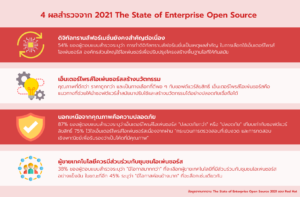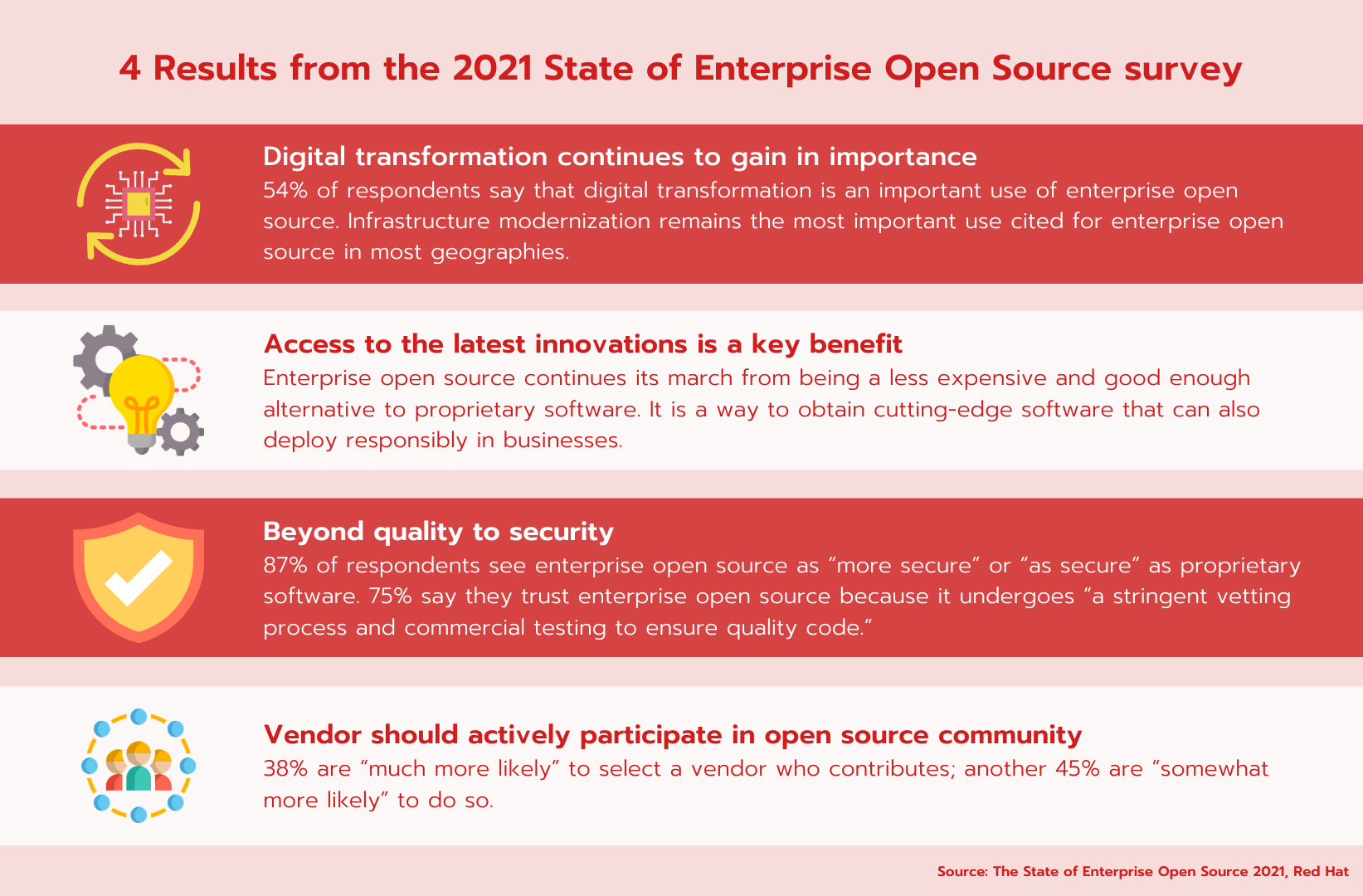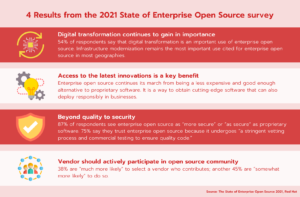
โดย กอร์ดอน ฮัฟฟ์
ผู้จัดการอาวุโสฝ่ายการตลาดผลิตภัณฑ์หลัก, เร้ดแฮท
นับเป็นปีที่สามที่เร้ดแฮทจัดทำรายงาน The State of Enterprise Open Source Report ซึ่งเป็นการสำรวจการใช้งาน และความคิดเห็นเกี่ยวกับเอ็นเตอร์ไพรส์โอเพ่นซอร์สของบริษัทต่าง ๆ ในปี 2564 นี้ เร้ดแฮทจัดให้มีการสัมภาษณ์ผู้นำด้านไอทีจำนวน 1,250 คนทั่วโลก ที่ไม่จำเป็นต้องเป็นลูกค้าของเร้ดแฮท และไม่ทราบว่าเร้ดแฮทเป็นผู้สนับสนุนการสำรวจนี้ ซึ่งช่วยให้เร้ดแฮทได้รับคำตอบที่ปราศจากอคติหรือการโน้มน้าวใด ๆ คำถามส่วนใหญ่จะเหมือนกับปีที่ผ่านมา ทำให้เราสามารถสำรวจแนวโน้มต่าง ๆ ได้ตลอดเวลา ในขณะเดียวกันเราได้เพิ่มคำถามใหม่ ๆ สองสามข้อไว้ในการสำรวจด้วย และได้รับคำตอบหนึ่งที่แม้แต่เราก็ไม่ได้คาดคิดมาก่อน
ไฮไลท์สำคัญจากรายงาน The 2021 State of Enterprise Open Source: A Red Hat Report
- การเปลี่ยนผ่านสู่ดิจิทัล เป็นเหตุผลอันดับต้น ๆ ในการเลือกใช้โอเพ่นซอร์ส
- เอ็นเตอร์ไพรส์โอเพ่นซอร์สเป็นเครื่องมือในการสร้างนวัตกรรม
- คุณสมบัติสำคัญของเอ็นเตอร์ไพรส์โอเพ่นซอร์สคือความปลอดภัย
- การมีส่วนร่วมของผู้ขายเทคโนโลยีในชุมชนโอเพ่นซอร์สเป็นสิ่งที่สำคัญ

ดิจิทัลทรานส์ฟอร์เมชั่นยังคงมีความสำคัญอย่างต่อเนื่อง
54% ของผู้ตอบแบบสำรวจกล่าวว่า ขณะนี้ความต้องการทำดิจิทัลทรานส์ฟอร์เมชั่นเป็นเหตุผลสำคัญในการเลือกใช้เอ็นเตอร์ไพรส์โอเพ่นซอร์ส เป็นตัวเลขที่เพิ่มขึ้นถึง 11 จุดจากในช่วงสองปีที่ผ่านมา ทั้งนี้หมวดหมู่ที่คล้ายคลึงกัน เช่นการพัฒนาแอปพลิเคชั่น และ DevOps ก็ได้รับคะแนนที่ใกล้เคียงกัน
ช่วงเวลานี้องค์กรส่วนใหญ่ต่างมุ่งมั่นปรับตัวสู่ดิจิทัล ข้อมูลจากรายงาน 2021 Global Tech Outlook ของเร้ดแฮท พบการให้ความสำคัญในด้านนี้เช่นกัน ทั้งนี้ผู้ตอบแบบสำรวจระบุว่าการทำดิจิทัลทรานส์ฟอร์เมชั่นเป็นสิ่งสำคัญอันดับแรกในการระดมทุนด้านไอทีที่ไม่ใช่เชิงเทคนิค และ 21% ของผู้ตอบแบบสำรวจระบุว่ากำลังเร่งแผนงานด้านดิจิทัล ซึ่งน่าจะเป็นการรับมือกับสถานการณ์โควิด-19
สิ่งสำคัญที่สุดที่องค์กรเกือบทุกภูมิภาคนำโอเพ่นซอร์สไปใช้ คือ นำไปใช้เพื่อปรับปรุงโครงสร้างพื้นฐานไอทีให้ทันสมัย ถึงแม้ว่าในทวีปยุโรป ตะวันออกกลาง และแอฟริกา (EMEA) มีการวางแผนจะทำดิจิทัลทรานส์ฟอร์เมชั่นพร้อม ๆ กันก็ตาม ซึ่งก็ไม่ใช่เรื่องที่น่าประหลาดใจแต่อย่างใด เพราะโอเพ่นซอร์สเป็นรากฐานของการปรับปรุงโครงสร้างพื้นฐานไอทีให้ทันสมัยอยู่แล้ว ทั้งนี้แรงกระเพื่อมของเอ็นเตอร์ไพรส์โอเพ่นซอร์สที่เกี่ยวข้องมากกว่ากับการริเริ่มทางธุรกิจที่สำคัญ (เช่น ดิจิทัลทรานส์ฟอร์เมชั่น) อาจคาดการณ์ได้ยาก
การเข้าถึงนวัตกรรมล่าสุดเป็นคุณประโยชน์หลักที่สำคัญ
แม้ว่าสิ่งสำคัญที่สุดในการใช้เอ็นเตอร์ไพรส์โอเพ่นซอร์สยังคงเป็นเรื่องของการปรับปรุงโครงสร้างพื้นฐานไอทีให้ทันสมัยแล้ว จะทำให้ข้อมูลในอดีตที่เป็นเรื่องของการลดต้นทุนโดยรวมถูกลดความสำคัญลงมาอยู่ในอันดับที่ห้าของรายการ ในทางกลับกันเอ็นเตอร์ไพรส์โอเพ่นซอร์สยังคงได้รับความนิยมต่อไป จากเหตุผลที่ผู้ใช้พิจารณาว่ามีราคาถูกกว่าและเป็นทางเลือกที่ดีพอ ๆ กับซอฟต์แวร์ลิขสิทธิ์ ไปจนถึงจุดที่ผู้ใช้เห็นว่าเป็นเทคโนโลยีที่ดีกว่าอย่างแท้จริง
โอเพ่นซอร์สดีกว่าในด้านใดบ้าง
ผู้ตอบแบบสำรวจระบุว่า สิ่งหนึ่งที่ดีกว่าของโอเพ่นซอร์สคือมีคุณภาพสูงกว่า นั่นคือคุณประโยชน์สูงสุดที่พวกเขาเห็นจากเอ็นเตอร์ไพรส์โอเพ่นซอร์ส ส่วนการใช้ประโยชน์จากเทคโนโลยีโอเพ่นซอร์สได้อย่างปลอดภัยนั้นมาเป็นอันดับที่สี่
สิ่งที่กล่าวมาข้างต้นนี้เชื่อมโยงกับคุณประโยชน์อันดับที่สอง คือ ความสามารถในการเข้าถึงนวัตกรรมได้เป็นอย่างดี การที่ผู้นำด้านไอทีที่ตอบแบบสำรวจครั้งนี้ได้กล่าวถึงคุณประโยชน์เหล่านี้ เป็นการชี้ให้เห็นว่าพวกเขาเห็นว่าเอ็นเตอร์ไพรส์โอเพ่นซอร์สคือแนวทางที่ช่วยให้พวกเขานำซอฟต์แวร์ล้ำสมัยมาปรับใช้ในธุรกิจของตนได้อย่างเชื่อถือได้
นอกเหนือจากคุณภาพคือความปลอดภัย
ความปลอดภัยถือเป็นคุณภาพชนิดหนึ่ง การที่ผู้ตอบแบบสำรวจจัดให้ความปลอดภัยสำคัญเป็นอันดับสามโดยพิจารณาจากเหตุผลสองประการ คือ ประการแรก ความปลอดภัยเป็นประเด็นร้อนแรง อีกประการหนึ่งคือผลกระทบด้านความปลอดภัยของความพร้อมใช้งานซอร์สโค้ดแบบอนาล็อก ที่ใช้ระบบการรักษาความปลอดภัยแบบกายภาพที่เคยเป็นประเด็นถกเถียงกัน (และยังคงเป็นประเด็นอยู่ในบางครั้ง)
แต่ในมุมมองที่ว่าโอเพ่นซอร์สโค้ดมีความเสี่ยงลดน้อยลงนั้น ผลสำรวจระบุว่า 30% ของผู้ตอบแบบสำรวจ เห็นว่าการรักษาความปลอดภัยที่ดีขึ้นเป็นหนึ่งในคุณประโยชน์สำคัญสามอันดับแรก ในขณะที่อีก 87%เห็นว่าเอ็นเตอร์ไพรส์โอเพ่นซอร์ส “ปลอดภัยกว่า” หรือ “ปลอดภัย” เทียบเท่ากับซอฟต์แวร์ลิขสิทธิ์
นอกจากนี้เรายังได้สำรวจความเห็นในวงกว้างมากขึ้น ซึ่งเราพบว่า 84% ของผู้ตอบแบบสำรวจระบุว่าเอ็นเตอร์ไพรส์โอเพ่นซอร์ส “เป็นส่วนสำคัญของกลยุทธ์ด้านความปลอดภัยขององค์กร” และอีก 75% กล่าวว่าพวกเขาไว้ใจเอ็นเตอร์ไพรส์โอเพ่นซอร์สเนื่องจากผ่าน “[…] กระบวนการตรวจสอบที่เข้มงวด และการทดสอบเชิงพาณิชย์เพื่อรับรองว่าเป็นโค้ดที่มีคุณภาพ”
ที่มาของนวัตกรรม
ชุมชนโอเพ่นซอร์สซอฟต์แวร์เป็นที่ที่นวัตกรรมจำนวนมากข้างต้นเกิดขึ้นในอุตสาหกรรมซอฟต์แวร์ปัจจุบัน การได้เห็นโครงการโอเพ่นซอร์สทั้งหมดในรูปแบบของคลาวด์เนทีฟ และแมชชีนเลิร์นนิ่ง ให้ความรู้สึกที่ดี ซึ่งเห็นได้จากตัวเลขผลสำรวจที่ยืนยันความคิดนี้ และเอ็นเตอร์ไพรส์โอเพ่นซอร์สยังมอบแนวทางให้ธุรกิจใช้ประโยชน์จากนวัตกรรมเหล่านั้นได้อย่างปลอดภัย
การให้บริการเอ็นเตอร์ไพรส์โอเพ่นซอร์สให้กับลูกค้าได้อย่างมีประสิทธิภาพสูงสุด จำเป็นต้องมีผู้ขายเทคโนโลยีที่เข้าร่วมโครงการโอเพ่นซอร์สต่าง ๆ ตั้งแต่เริ่มต้น นั่นคือวิธีที่เร้ดแฮทพัฒนาความเชี่ยวชาญที่จำเป็นต่อการรองรับผลิตภัณฑ์ต่าง ๆ ของบริษัทฯ สิ่งนี้เป็นสิ่งที่ทำให้เร้ดแฮทอยู่ในจุดที่ดีที่สุดในการกำหนดทิศทางของโครงการเพื่อประโยชน์ของลูกค้า แต่มีคำถามว่าผู้นำด้านไอทีทั้งหลายให้ความสำคัญกับเรื่องนี้หรือไม่ และมองเห็นความแตกต่างระหว่างผู้ขายเทคโนโลยีที่นำเสนอโครงการโอเพ่นซอร์สแบบเรื่อยเฉื่อย กับผู้ขายที่ช่วยผลักดันโครงการให้เกิดความก้าวหน้าอย่างกระตือรือร้นหรือไม่
ตอนที่เราตัดสินใจเพิ่มคำถามใหม่นี้ เร้ดแฮทคาดว่าจะมีผู้ตอบแบบสำรวจเพียงไม่กี่คนที่จะให้ความสนใจเรื่องนี้ แต่เราคาดการณ์ผิด และต้องยกความดีความชอบนี้ให้กับผู้ตอบแบบสำรวจที่ 38% ระบุว่า “มีโอกาสมากกว่า” ที่จะเลือกผู้ขายเทคโนโลยีที่มีส่วนร่วมกับชุมชนโอเพ่นซอร์ส ในขณะที่อีก 45% ระบุว่า “มีโอกาสค่อนข้างมาก” ที่จะเลือกเช่นนั้น
ข้อสรุป
การศึกษาเรื่องเอ็นเตอร์ไพรส์โอเพ่นซอร์สที่เร้ดแฮท ได้ดำเนินการมาเป็นเวลาสามปีได้บอกเล่าเรื่องราวทั้งหมดอย่างชัดเจน ผู้นำด้านไอทีจำนวนมากเห็นว่าโอเพ่นซอร์สซอฟต์แวร์เป็นซอฟต์แวร์ที่เหนือชั้นด้วยคุณภาพที่สูงกว่า มีนวัตกรรมมากกว่า และมีความปลอดภัยมากกว่าทางเลือกอื่น ๆ
นอกจากนี้ พวกเขายังพึงพอใจกับคุณค่าทั้งหมดของเอ็นเตอร์ไพรส์โอเพ่นซอร์สที่ได้รับบริการจากผู้ขายเทคโนโลยีที่มีส่วนร่วมอย่างแข็งขันในการพัฒนาโอเพ่นซอร์ส มากกว่าผู้ขายที่เพียงแค่นำโค้ดที่เป็นโอเพ่นซอร์สมาเรียบเรียงเป็นผลิตภัณฑ์เพื่อขายเท่านั้น ในภาพรวม เป็นที่ยอมรับกันว่าเอ็นเตอร์ไพรส์โอเพ่นซอร์สกำลังเพิ่มประสิทธิภาพให้กับอนาคตของซอฟต์แวร์
กรุณาอ่านรายงานฉบับเต็มได้ที่ The State of Enterprise Open Source: A Red Hat Report

